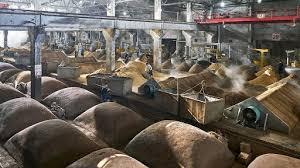


Before 2015, corn based ethanol producers also experienced high input price caused by the corn price support program. Since the ethanol price is proportional to the gasoline price, ethanol producers in China have suffered due to low oil prices.
#China stockpile trial
The fuel companies then blend ethanol with gasoline, and distribute the resulting E10 fuel in the trial areas where only E10 fuel is allowed to be sold. They sell ethanol to designated state-owned fuel companies at 91.11 percent of market gasoline wholesale price. State-approved ethanol refineries are exclusive suppliers in the nearby trial areas. Trial areas, selected based on proximity to production, expanded from several cities in 2002 to six provinces and more than 30 cities today. The production and distribution of ethanol in China is integral to the regional E10 trial program. However, cellulosic ethanol production is not expected to reach large scale production until 2025 (NEA 2017). Recently, China has been encouraging ethanol production using cellulosic feedstock (called generation 2). Cassava refineries are located in southern China, close to domestic and foreign cassava production regions (Figure 3). However, it is challenging to grow enough generation 1.5 feedstock domestically, and cassava refineries in China still heavily rely on imports (IEA Bioenergy 2016). Cassava, a tuberous starchy root commonly grown in tropical and sub-tropical areas, became the second-largest source of feedstock, currently accounting for 23 percent of total output. By calling for “appropriate development of grain-based ethanol,” the current national E10 mandate relaxes the government’s previous stance against corn-based ethanol.Īfter China halted the development of generation 1 ethanol in 2006, it shifted support to “generation 1.5” feedstock, such as cassava and sweet sorghum. As the stockpile decreased and refineries started to use newly harvested corn for feedstock, the government stopped approving additional generation 1 ethanol refineries in 2007 (CDRC 2007). 1 The four state-owned corn ethanol producers, located in corn producing regions in northern China (see Figure 3), were established after the regional trial started in 2002, following a historical peak in corn stockpile. China’s regional E10 mandate trial areas and ethanol refineries (annual production capacity is under location name)Ĭorn is China’s main feedstock (called generation 1, see Figure 1) for ethanol production, currently accounting for 64 percent of total output. Current Situation of China’s Ethanol Industryįigure 3. The E10 mandate will further increase the demand for corn and speed up reduction of the stockpile. These measures have been effective-since 2015, China’s corn consumption has caught up with production, the price for corn dropped to the lowest point in six years, and ending stock has been decreasing (USDA 2017b). These measures include replacing the support price with a producer support based on planted area and financial assistance for corn processors. Burdened by high storage cost, food safety risks, and potential waste, China recently adopted multiple measures to cut supply and increase demand. The stockpile is the result of a corn price support policy that was paying Chinese corn producers more than twice the international price level until 2016 (Wu and Zhang 2016). This is about half of the world ending stocks and enough for China’s domestic consumption for half a year (Wu and Zhang 2016).

Source: USDA FAS: world market and trade Backgroundīeyond environmental benefits, a key motivation for the E10 mandate is to reduce China’s large corn stockpiles, which peaked in 2015/2016 at over four billion bushels (Figure 1, sources from China estimate the stockpile to be much larger).


 0 kommentar(er)
0 kommentar(er)
